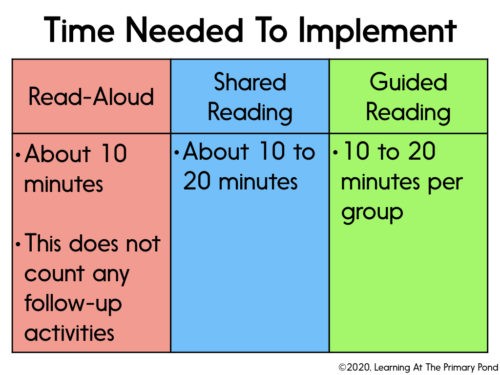Literacy instruction is filled with specific terms, and understanding them is essential for educators. Among these terms, “read-aloud,” “shared reading,” and “guided reading” are often used, but it’s crucial to recognize their distinct differences to effectively support student growth. This post will clarify the differences between shared and guided reading, providing insights into how each instructional practice can benefit students in unique ways.
It’s helpful to understand these instructional routines by comparing key areas: timeframe, skills addressed, teacher’s role, students’ role, and text difficulty. Let’s examine shared reading and guided reading more closely.
Timeframe
While both shared reading and guided reading sessions require dedicated time, guided reading often involves smaller groups and more individualized attention, potentially extending the session length depending on student needs. Shared reading, conducted with the whole class or larger groups, tends to have a more consistent timeframe.
Skills to Cover
Shared reading and guided reading are both valuable for covering a wide range of literacy skills. Shared reading allows for explicit teaching of reading strategies and concepts of print using an enlarged text. Guided reading focuses on applying these strategies in a small group setting with texts at the students’ instructional level. Both approaches prepare students for independent reading by developing essential reading skills.
Teacher’s Role
In shared reading, the teacher acts as a facilitator, guiding the whole class through the reading process, modeling strategies, and prompting student participation. In guided reading, the teacher provides more individualized support within a small group, observing student reading behaviors, offering targeted instruction, and scaffolding learning as needed. The teacher’s role shifts from a director to a facilitator as students become more independent.
Students’ Role
During shared reading, students actively participate as a whole class, contributing to discussions, making predictions, and sharing their thinking. In guided reading, students take on a more active role in reading the text independently, applying learned strategies, and problem-solving with teacher support. The focus shifts from collaborative reading to independent reading with guidance.
Text Difficulty
Shared reading typically uses texts that are slightly above the students’ independent reading level, allowing them to access more complex vocabulary and concepts with teacher support. Guided reading employs texts at the students’ instructional level, providing a balance between challenge and support, enabling students to practice strategies independently with occasional guidance.
In summary, shared reading offers a collaborative experience with a focus on modeling and explicit instruction, while guided reading promotes independent reading with targeted support in a small group setting. Both approaches are valuable for developing students’ reading skills and fostering a love of reading.
